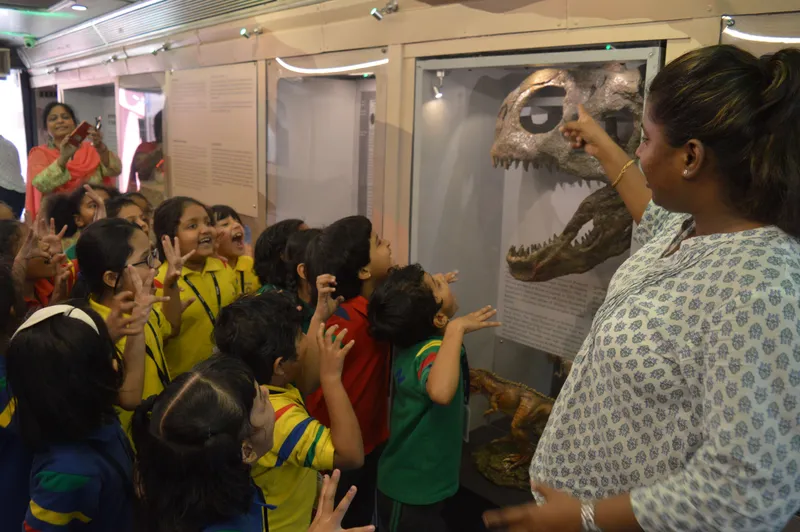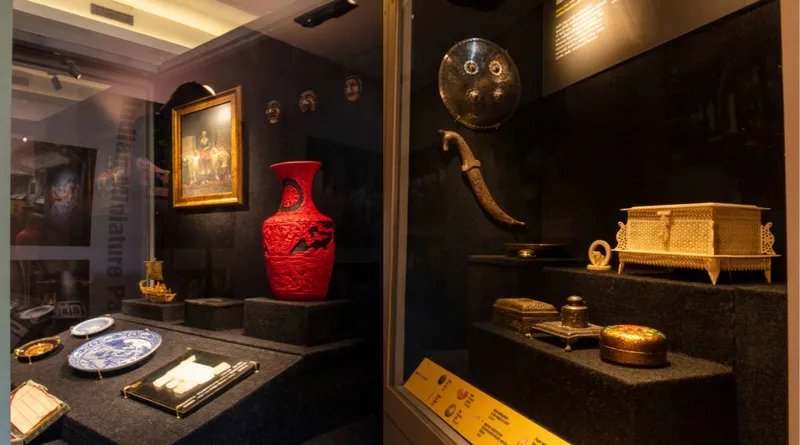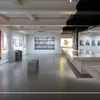Mumbai’s Museum on Wheels is taking art, history, and culture to children’s doorstep
Started in 2015 by the Chhatrapati Shivaji Maharaj Vastu Sangrahalaya (CSMVS) in Mumbai, Museum on Wheels aims to reach out to children, especially in rural areas, to make knowledge and learning more accessible.
As the doors of the blue-coloured bus swing open, children–from first graders to the curious tenth graders–step into a world of art, culture, and history. With their faces reflecting a blend of curiosity and anticipation, they wander about the mobile museum, a first of a kind experience for them, which has remained distant and inaccessible for many years.
The Museum on Wheels is an initiative by Chhatrapati Shivaji Maharaj Vastu Sangrahalaya (CSMVS) in Mumbai. An iconic art and history museum in India, the UNESCO World Heritage Site is over 100 years old, and houses a collection of 70,000 historical works from India and abroad.
The mobile museum has meticulously arranged artifacts to immerse visitors in a vibrant tapestry of sound, each piece whispering untold stories of its history. The digital screens, set at the corners, display intricate details of musical instruments like violin and piano, providing children with the opportunity to compose their very own melodies and rhythms.
Started in 2015, the mobile museum, which is an air-conditioned bus, is not merely a collection of artifacts, but a mobile gateway to the world of art and history, one that aims at igniting spark and imagination among children, especially in rural areas, by reaching them right at their doorstep.
“The definition of museum in India is confined to a brick room and a collection of artifacts, and this is the very perspective we aim to change through the Museum on Wheels. The moment museums adapt more diverse roles than just being a building, people will understand their true essence—which is to educate people about art, culture, and history,” says Krutika Mhatre, Project Manager of the Museum on Wheels.
“If children cannot come to the museum, then why not just take it to them,” she adds.
How it started?

Museum of Wheels was started in 2015
In 2015, CSMVS approached the Ministry of Culture with the idea of Museum on Wheels. The aim of this programme was to bring museums closer to people, especially in remote areas. The Ministry of Culture welcomed the idea and provided them with an air-conditioned bus. Later, in the same year, Citi Bank partnered with them and provided funds for the initiative. Seeing the success of the programme, the bank provided them with a second bus in 2019.
For the past eight years, this project has achieved remarkable success by utilising two specially-designed air-conditioned buses that serve as mobile exhibition spaces.
“Having an understanding of our culture, history, and art is extremely important. Hence the primary objective of this project is to revolutionise the museum experience by making history and art more accessible to individuals residing in both urban centers and remote regions,” says Atreyee Chakravarty, an education facilitator associated with the project.

The bus has travelled to over 678 places and reached 14 lakh individuals across the country
However, the journey so far has not been easy. Mhatre recalls that when they started their journey, they did not have a fixed manual to follow.
“We did not have a pre designed model to follow. We were designing the buses, deciding the themes, managing navigation, and setting protocols, all for the first time. It was a unique experience for us as well, and with time, and some minor ups and downs, we managed to make our way ahead,” she adds.
Taking the knowledge portal to the doorstep

Facilitators conduct sessions in Hindi, Marathi, and English.
The theme of the exhibition is inspired by the curriculum of the students, and these themes change every year. Some of the past themes have been history of Indian money, a display of the Harappan civilisation, and a display of fossils.
The presentation involves a variety of engaging elements such as exhibits, tactile replicas, demonstrative kits, interactive multi-touch tablets, and captivating audio-visual presentations. They also conduct art and craft activities to offer a fun learning experience to the students.
These sessions are open at a particular school throughout the day during local visits. However, for outstation visits, the project endeavours to maximise its impact by visiting two or more areas in a single day.
“Our opening and closing time is determined by the school timings, as some institutions work on morning shifts and some operate during the afternoon. Depending on the number of students we need to cover and the estimated time it would take to conduct allied activities and workshops, we sometimes keep the bus at the same institution over two to three days, with the aim of allowing each student enough time to absorb the exhibition and its offerings,” Chakravarty says.
Since its launch, there have been eight mobile exhibitions held in various schools, colleges, and NGOs catering to children in states like Karnataka, Maharashtra, Goa, Gujarat, Haryana, and Delhi NCR region. It has covered 23 districts across Maharashtra, including Nagpur, Solapur, Satara, Sindhudurg, Ratnagiri and more; 10 districts across Gujarat, including Bharuch, Ahmedabad, Rajkot, Junagadh, Anand, Vadodara, and more. It has also covered eight districts across Karnataka and Goa, which include Bellary, Kalaburagi, Vijayanagara, Ponda, Kundaim, Calangute, Miramar, Bambolim, and more.
The bus has travelled to over 678 places and reached 14 lakh individuals across the country, covering a distance of 85,359 km. The team further plans to add three to four new districts every year to the states they have been catering to so far.
“We conduct sessions in Hindi, Marathi, and English. As we often venture into the interiors of Maharashtra, we ensure that we have facilitators who are fluent in the local language. But as the project is venturing into states like Karnataka and Gujarat, we are taking the assistance of local educators and student volunteers to help with translation. With every visit conducted outside Maharashtra, we also make an attempt to publish our exhibition handouts and brochures in the local language of the targeted region,” Chakravarty explains.

Chhatrapati Shivaji Maharaj Vastu Sangrahalaya (CSMVS) in Mumbai houses a collection of 70,000 historical works from India and abroad
Currently, the two buses are set up according to two themes– ‘In tune: The journey from sound to Music’ and ‘100 years of CSMVS’. The first one talks about music and its history, while the second celebrates 100 years of the CSMVS.
“Most of the artifacts placed inside the bus are replicas of the originals kept at CSMVS, which are made by our in-house artists as we cannot keep the original ones in a moving bus,” Mhatre says. Elucidating further, she says, each case can accommodate one to 15 articles depending on the size of the exhibition.
Currently, the museum has three facilitators who have been hired on a contractual basis for three to six months. These facilitators take the visitors around the museum.
“Since we have students coming from varied grades, the facilitators tailor their teaching methods to cater to different students. This allows us to create a welcoming and engaging learning environment, where every student can comfortably grasp the information being presented,” Mhatre explains.
Mhatre further says that in the beginning, the museum reached out to schools, colleges, and NGOs in Mumbai. But now, after eight years, they get requests from institutions and residential complexes.
Complementing the primary project, the museum also operates the Think Museums Project—an innovative initiative that provides opportunities to schools to collaborate with CSMVS and curate museum-like exhibitions as part of their learning and knowledge-sharing endeavors.
Edited by Megha Reddy







